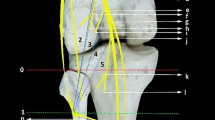Abstract
Spastic pes equines, possibly associated with varus posture or spastic claw of the toes, can require neurosurgical treatment. In these cases, a selective fascicular neurotomy can be proposed, which consists of a partial section of some motor collateral branches of the tibial nerve. In order to avoid sensory and trophic complications after surgery due to an excessive manipulation of the nerve, accurate anatomical data must be collected. Therefore, biometric, histological and ultrastructural studies were carried out. A total of 50 dorsal compartments of the leg were dissected. The distance between the emergence of each muscular branch of the tibial nerve and anatomical landmarks were measured. Complementary histological study was processed on three specimens with slices stained by Masson’s trichromatic method. Eventually, electronic microscopy observation was processed on two other specimens. In 16 cases (32%), we found a common muscular branch for all the muscles of the dorsal leg compartment, which emerged from the nerve trunk near the tendinous arch of the soleus (67 ± 29 mm from the femorotibial articular line). In the other cases, muscular branches of the nerve emerged from its ventral lateral aspect, with variable origins (inferior nerve for the soleus: 82 ± 31 mm from the femorotibial articular line, nerve for flexor digitorum longus: 116 ± 41 mm, nerve for tibialis posterior: 106 ± 51 mm, with a second nerve in 9/50 cases, nerve for flexor hallucis longus: 129 ± 48 mm, with a second nerve in 6 cases). Histological and ultrastructural analysis confirmed the presence of the motor nervous fibers in the ventral lateral part of the nerve trunk. These new anatomical findings allow a more precise dissection during operative procedure, in order to avoid sensory or trophic complications.




Similar content being viewed by others
References
Boyd IA, Davey MR (1968) Composition of peripheral nerve. Edinburg, Livingstone
Buffenoir K et al (2004) Spastic equinus foot: multicenter study of the long-term results of tibial neurotomy. Neurosurgery 55(5):1130–1137
Buffenoir K, Decq P, Lefaucheur JP (2005) Interest of peripheral anesthetic blocks as a diagnosis and prognosis tool in patients with spastic equinus foot: a clinical and electrophysiological study of the effects of block of nerve branches to the triceps surae muscle. Clin Neurophysiol 116(7):1596–1600
Chua KS, Kong KH (2001) Clinical and functional outcome after alcohol neurolysis of the tibial nerve for ankle-foot spasticity. Brain Inj 15(8):733–739
Decq P et al (1998) Role of soleus muscle in spastic equinus foot. Lancet 352(9122):118
Decq P et al (2000) Soleus neurotomy for treatment of the spastic equinus foot. Groupe d’Evaluation et de Traitement de la Spasticité et de la Dystonie. Neurosurgery 47(5):1154–1160; discussion 1160–1161
Feve A et al (1997) Physiological effects of selective tibial neurotomy on lower limb spasticity. J Neurol Neurosurg Psychiatry 63(5):575–578
Kim DH et al (2003) Surgical management and results of 135 tibial nerve lesions at the Louisiana State University Health Sciences Center. Neurosurgery 53(5):1114–1124; discussion 1124–1125
Lance JW (1980) Symposium synopsis. In: Y. R. Feldman RG, Keolla WP (eds) Spasticity: disordered motor control. Year Book Medical Publishers, Chicago, pp 485–494
Lumsden DB et al (2003) Topography of the distal tibial nerve and its branches. Foot Ankle Int 24(9):696–700
Sindou M, Mertens P (1988) Selective neurotomy of the tibial nerve for treatment of the spastic foot. Neurosurgery 23(6):738–744
Stoffel A (1912) The treatment of spastic contractures. Am J Orthop Surg 10:611–644
Taira T, Hori T (2003) The role of neurosurgical interventions for control of spasticity in neurorehabilitation: new findings on functional microanatomy of the tibial nerve. Acta Neurochir Suppl 87:103–105
Acknowledgments
The authors wish to thank M. Demeulaere, G. Lefebvre and F. Stevendart (Laboratory of Anatomy) for their skilful help during dissections and N. Goetynck for her expert help during the ultrastructural study.
Author information
Authors and Affiliations
Corresponding author
Rights and permissions
About this article
Cite this article
Baroncini, M., Baïz, H., Wavreille, G. et al. Anatomical bases of tibial neurotomy for treatment of spastic foot. Surg Radiol Anat 30, 503–508 (2008). https://doi.org/10.1007/s00276-008-0359-9
Received:
Accepted:
Published:
Issue Date:
DOI: https://doi.org/10.1007/s00276-008-0359-9




